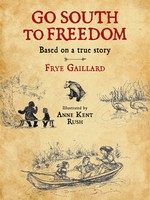The road to freedom was long, dark and dangerous for many 19 th century slaves, and a new historical novel by writer Frye Gaillard brings to young readers an enlightening tale of the struggle faced …
This item is available in full to subscribers.
Please log in to continue |


The road to freedom was long, dark and dangerous for many 19th century slaves, and a new historical novel by writer Frye Gaillard brings to young readers an enlightening tale of the struggle faced by those who dared to dream of a better life.
"Go South to Freedom," published in September by NewSouth Books, is Gaillard's first venture into young adult literature. It is aimed at readers from ages 10-13 (Grades 5-8). A teacher's guide was developed by a pair of University of South Alabama education professors to enhance the book's worth as a learning tool, and it is available from the publisher as a free download.
Robert Croshon was the Gaillard family gardener during the author's youth, and he would often push young Frye around in a wheelbarrow in his grandfather's yard. The novel is based on an oral history told to Gaillard by the aging man after the little boy became an adult and returned to visit his hometown of Mobile.
"I liked him very much. He was a man of great kindness and dignity," Gaillard said. "The story that he told me is sort of the skeleton of the story that I tell in this book."
Gaillard noted the story had been passed down in Croshon's family for about 100 years, and was "carefully preserved and kept alive as part of the family's sense of itself."
The man's ancestor, Gilbert Fields, was an African-born slave who led his family from Georgia in a quest for freedom. They ran away one night, with plans to travel north under the cover of darkness. But when a thunderstorm blocked the stars they had hoped to use as a navigational guide, they realized they were actually traveling south.
Gaillard said they eventually sought shelter in a cave where they could hide during the day while deciding what to do next.
"It turned out the cave was occupied by a runaway slave who told them two things: that slaves sometimes found sanctuary with the Seminole Indians in Florida in the Everglades, and they sometimes went to the city of Mobile, he said."
It was in Mobile in the 1830s where "free people of color" lived and Fields' family could settle. Gaillard said that newfound freedom dated back to an era when Mobile was a French or Spanish city, with some of the former slaves having been set free by their owners.
Gaillard touched briefly on this oral history in an earlier book, but said "it occurred to me later it might be a great story for young readers, and when I decided to do that I decided to flesh it out by studying the history this oral history touched on and discovered by reading some books that the Seminole Indians did in fact take in some runaway slaves. There was a whole group of people known as black Seminoles that often lived in contiguous villages to the Native American Seminoles, and also fought alongside them in the Seminole Wars because those wars were aimed at not only subduing and removing the Indians, but also recapturing runaway slaves and returning them to slavery."
Gaillard said all this is documented history, but it is not very well known, admitting he was unaware of it himself before talking with Croshon. He further researched the topic by reading dissertations, and discovered that the free people of color in Mobile could have lost their own freedom by harboring escapees from other areas.
"I wrote this as a historical novel," Gaillard said. "It expands and embellishes the known facts about Gilbert Fields, and it has some real historical characters in it like the Indian chief Osceola, one of the Seminole war chiefs, and a black Seminole war chief named John Horse. Andrew Jackson is mentioned in the book, among others.
"My hope is that this little book will help humanize our history a little bit."
Irene Latham, author of "Leaving Gee's Bend," penned one of Gaillard's favorite reviews of his new novel. She wrote, "'Go South to Freedom' is a campfire story for all ages, filled with surprise and adventure, truth and sadness, and ultimately hope. Readers experience the great pull of freedom in this account of the courageous efforts of the African and other enslaved people to make their lives better. Inspiring and entertaining."
"Go South to Freedom" is illustrated by Alabama artist Anne Kent Rush, and is available at neighborhood bookstores and online.
Gaillard will visit The Book Cellar at Page & Palette (32 S. Section St. in Fairhope) on Saturday, from 3-4 p.m., to sign copies of the book. For more information about the event, call the store at 251-928-5295.